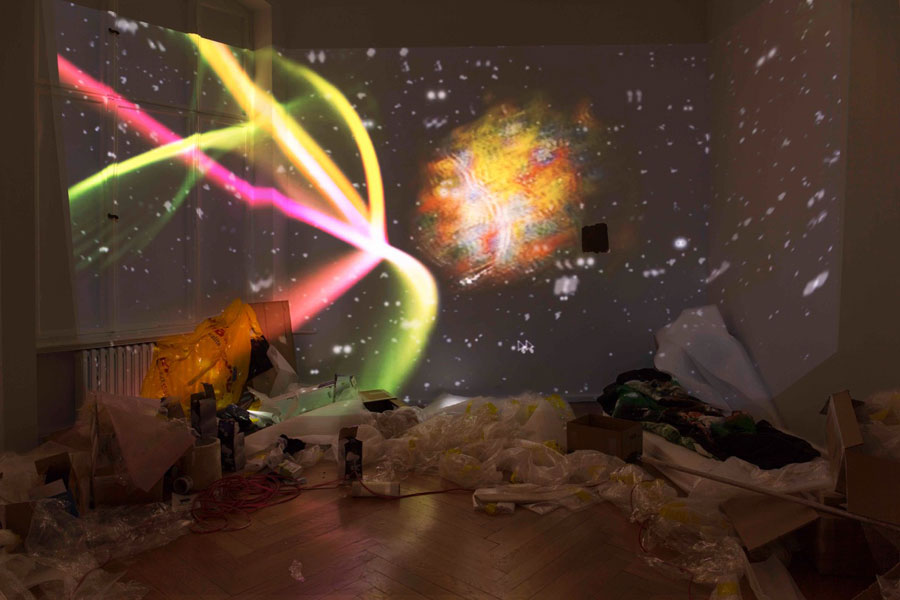Trisha Baga
Société, Berlin, Germany
Société, Berlin, Germany

Waiting rooms are places where we often realize how little we can actually control. There we sit, fidget, fret, hope and take silent inventory of our bodies. American artist Trisha Baga translates such vulnerability into the objects that were on display in her exhibition ‘LOAF’ at Société, Berlin. In what one gallery assistant likened to a waiting room, an untitled series (all works 2016) of around 30 glazed ceramic works is displayed on carpeted pedestals, the floor and wall, alongside a cheap rotating fan, some magazines and a set of Jean Prouvé-style stacking chairs. Like wry pop objects, Baga’s ceramics are loose renderings of everyday items, such as a desktop printer, spiral-bound calendar and bread. They blend deliberate mishap with humour. For instance, a miniature of Michelangelo’s Pietà (1498–99), seemingly made of cheese, appears mid-melt (Baked Brie Pietà), while a work resembling a toasted light switch is called Bad Wiring. A bust depicts the sunburnt founder of Kentucky Fried Chicken: Colonel Sanders with a Sunburn Taking an Eye Exam, a dog bowl has breasts (Dog Bowl with Boobs) and Ellen Degeneres is a brain-sized blob.

Emphasizing malleability and volatile forms, Baga’s works draw from popular culture and point to crises of containment and communication in today’s networked society and politics. There Is Nothing Simple about Hillary Clinton and Mad Genius, Manic Diva (a reference to Nicki Minaj) are formed from magazine covers showing these personalities. Ceramic objects placed on top mimic and obscure segments of their portraits. Expressionist, prosthetic-like depictions of Photoshopped celebrities, these pieces resonate with a media environment in which perpetual updates and filters obscure the narratives that the press once aimed to perfect. Nonetheless, while as individual objects Baga’s ceramics are strong, taken together they present a combination of childishness and abjection that falls short of being compelling. The room is funny, but it feels accidental.

Messiness is key to Baga’s 3D video installations, whose cluttered and sprawling environments suggest that, today, our interior spaces are collateral to our lives, which are lived primarily via screens. Her works thrive on accumulation: packaging materials, used envelopes, carelessly snaking wires, a lone mattress on the floor. But, while dishevelment as an aesthetic can be affecting, here the installations simply appear abandoned. The 3D video Ghost is screened above a cluttered desk and empty chair. The non-linear sequence of home-movie vignettes shows Baga’s family visiting their native Philippines, road-tripping and dancing in electronics stores. Slow-moving, alarming smoke billows in archives and desert landscapes, while an invisible protagonist tries whimsically to convince the viewer that she’s real. The video’s narrative, which combines found material from English language courses with documentary footage by the artist, mentions several times that when Alexander Graham Bell made the first telephone call he had no one
to dial. Here again, Baga’s approach to topics such as visibility and failed communication is droll. Yet, the result feels frantic rather than urgent – upset; yet not offering any solutions.
Baga began her career performing in front of her single-channel videos. She gradually replaced her own body with the found and manipulated objects that we see in her installations today. But she did so as an exercise in self-reflection. ‘I needed something else to perform for my body, so I could walk away and work on something else, or even step far enough away from it so I can see it’, Baga said in an interview. Like the show’s title, ‘LOAF’ – which alludes not only to the ‘baking’ of the glazed ceramic but also to laziness – the way Baga realizes her interests in precariousness and in the body as formless subject feels lackadaisical, half-baked even.
























